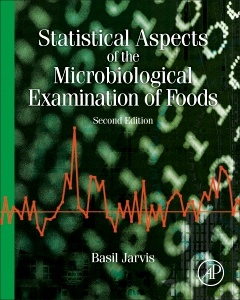Statistical Aspects of the Microbiological Examination of Foods (3rd Ed.)
Auteur : Jarvis Basil

Statistical Aspects of the Microbiological Examination of Foods, Third Edition, updates some important statistical procedures following intensive collaborative work by many experts in microbiology and statistics, and corrects typographic and other errors present in the previous edition. Following a brief introduction to the subject, basic statistical concepts and procedures are described including both theoretical and actual frequency distributions that are associated with the occurrence of microorganisms in foods. This leads into a discussion of the methods for examination of foods and the sources of statistical and practical errors associated with the methods. Such errors are important in understanding the principles of measurement uncertainty as applied to microbiological data and the approaches to determination of uncertainty.
The ways in which the concept of statistical process control developed many years ago to improve commercial manufacturing processes can be applied to microbiological examination in the laboratory. This is important in ensuring that laboratory results reflect, as precisely as possible, the microbiological status of manufactured products through the concept and practice of laboratory accreditation and proficiency testing. The use of properly validated standard methods of testing and the verification of ?in house? methods against internationally validated methods is of increasing importance in ensuring that laboratory results are meaningful in relation to development of and compliance with established microbiological criteria for foods.
The final chapter of the book reviews the uses of such criteria in relation to the development of and compliance with food safety objectives. Throughout the book the theoretical concepts are illustrated in worked examples using real data obtained in the examination of foods and in research studies concerned with food safety.
1. Introduction2. Some basic statistical concepts3. Frequency distributions4. The distribution of microorganisms in foods in relation to sampling5. Statistical aspects of sampling for microbiological analysis6. Errors associated with preparing samples for analysis7. Errors associated with colony count procedures8. Errors associated with quantal response methods9. Statistical considerations of other methods in quantitative microbiology10. Measurement uncertainty in microbiological analysis11. Estimation of measurement uncertainty12. Statistical process control using microbiological data13. Validation of microbiological methods for food14. Risk assessment and microbiological criteria for foods
He has served on numerous official advisory groups, including the statistics group of the AOAC Presidential Taskforce on ‘Best Practices in Microbiological Methods’. He is also a member of the ISO working group on Microbiological Statistics. He is a Past President and Honorary Member of the Society for Applied Microbiology, a Fellow of the Royal Society of Biology and a Fellow of the Institute for Food Science and Technology. Although now retired, he retains his interests in teaching students and considers statistics to be a relaxing hobby, especially when accompanied by a glass of fine wine!
- Includes additional figures and tables together with many worked examples to illustrate the use of specific procedures in the analysis of data obtained in the microbiological examination of foods
- Offers completely updated chapters and six new chapters
- Brings the reader up to date and allows easy access to individual topics in one place
- Corrects typographic and other errors present in the previous edition
Date de parution : 06-2016
Ouvrage de 352 p.
19x23.3 cm
Thèmes de Statistical Aspects of the Microbiological Examination... :
Mots-clés :
acceptable limits; acceptance sampling; accuracy; ANOVA; AOAC; AQL; attribute charts; attributes sampling; binomial; cause and effect diagrams; colony count procedures; confidence intervals; consumer's risk; counting errors; CUSUM; CUSUM signal plots; diluent volume errors; distribution models; electronic cell counting; food safety objectives; frequency distributions; goodness-of-fit test; harmonisation; hypotheses; impedance; intermediate reproducibility; ISO; laboratory sampling; likelihood ra



